► Audi A3 Sportback e-tron driven on UK roads
► Petrol-electric hybrid with plug-in charge ability
► A better buy than an ordinary A3? Not necessarily
It’s not hard to see why plug-in hybrids are becoming a must-have for mainstream carmakers.
Adding larger batteries, rechargeable through the mains, to the usual hybrid recipe means you get a more meaningful electric-only range, yet without any added range anxiety. With the engine able to charge the batteries too, it’s not a disaster if you’re not able to plug it in every day, but a bonus if you can.
And a bonus for the manufacturers themselves because, in the EU at least, the electric-only range can be carried wholesale into the CO2 emissions calculations. That means headline-grabbing gram-per-kilometre figures, and a lower official CO2 average for a company’s model range as a whole.
Industry insiders believe widespread use of pure electric vehicles, or a better alternative, is still realistically a couple of decades away so in the interim, we can expect to see plenty more plug-in hybrids (PHEVS) join the market. Mercedes-Benz alone plans to add 10 plug-in hybrid models to its range by 2017.
Audi A3 e-tron: the overview
So this car, the Audi A3 e-tron, makes perfect sense – on paper at least. Based on Audi’s five-door A3 Sportback, its primary power source is a 148bhp 1.4-litre turbocharged petrol engine, repositioned slightly under the bonnet to make space for an additional 100bhp electric motor, conjoined with a six-speed dual-clutch automatic transmission.
Ever so slightly different headlights and subtle badges aside, it looks all but identical to an ordinary A3. That’s a good thing, I reckon. Not every hybrid has to disclose its identity. The charging socket’s hidden behind the Audi rings on the nose, revealed by a neat little badge sidestep. A relatively speedy four hours-ish sees it fully charged through the mains, or a little over two hours from a fast-charge point.
Electric-only range is quoted as 31 miles. That’s quite a generous figure, as the project director for BMW’s upcoming 3-series plug-in told us research suggests most of that car’s projected customers won’t drive more than 19 miles a day in total.
The e-tron can manage as much as 80mph under electric power alone but, quite obviously, you’re best to rely on the engine for high-speed stuff and save the motor for urban work.

First of all: the good stuff
This being an A3, there’s plenty to like. One of, if not the, best mainstream interiors around today for a start. The minimally styled, expensive-feeling cabin still impresses, even if the dashboard in our particular test car did develop an annoying intermittent rattle on bumpy roads.
There’s the same smooth steering and stable, predictable handling too. But you can feel that the e-tron is a heavier car than the regular Sportback, and by a considerable margin. The lithium-ion battery, mounted on the border beneath the boot floor and rear seats, weighs 125kg alone and the car as a whole weighs more than 1.6 tonnes.
There are four selectable driving modes – EV, Auto, Hold, and Charge. The first two are self-explanatory: EV uses the electric motor only for as long as possible, Auto swaps between, or combines, motor and engine as it sees fit. Hold uses the engine only to preserve the battery’s level and Charge makes sure the engine’s doing its best to replenish it, albeit at the partial expense of fuel economy.
In the interests of science, I left the e-tron in Auto for my very short, largely urban commute and it tackled it under electric power alone. It wasn’t until the morning of my third day with the car that the engine woke from its slumber, and that was without any top-up charges in the meantime.
When the engine did fire, it blared into life abruptly under a bit of heavy throttle leaving a junction. Suddenly jumping to high revs from stone cold seems a hard lot for an engine, but the 1.4 TSI unit’s architecture, along with various internal material upgrades for the e-tron, are designed to warm it through as quickly as possible on start-up.
Thanks to that electric range, the e-tron’s official fuel economy and emissions figures are just as arresting as you’d expect: 176mpg and 37g/km. But our mpg display on the trip computer didn’t quite crack three figures. Best I saw were indicated mid-50s after a bout of mixed urban and dual carriageway driving.

Audi A3 e-tron: the less good stuff
Boot space is down by around 25% because of the need to somehow fit both the battery and a fuel tank into the car’s innards. And if you’re carrying the unusually bulky charger unit and cables, which presumably you usually would be, they steal plenty of boot space too.
While it’s a largely pleasant car to drive, it’s less so than an ordinary A3. Quite apart from the extra weight, there’s the odd-feeling brakes to contend with. The pedal feels springy underfoot, and the rate at which the car slows feels inconsistent and difficult to judge – presumably because some of the time the electric motor’s helping to decelerate the car, but other hybrids mask this effect better.
There’s more of a jolt when the engine chimes in than with most hybrids too, and our test car also shunted uncomfortably and unpredictably when going from reverse gear to forward. Maybe there’s an Audi-branded neck brace in the options list somewhere. And when the engine does come to life, it somehow sounds harsher and less sweet than other VW Group cars powered by the same 1.4 TSI unit.
Would you want a second-hand A3 e-tron? The battery comes with an eight-year/100,000-mile warranty, but wouldn’t be cheap to replace if anything goes wrong beyond that point, and there are various potential environmental ramifications for its end-of-life disposal.
It’s difficult to quote a specific general fuel economy figure for the A3 e-tron because it all depends how far you’re travelling, and how much of the electric capability you’re using. And if you want to make it even more complicated you could also factor in your electricity bill if you’ve pre-charged the batteries.
From a tax point of view, the car’s not without its attractions. Company car drivers would only pay a 5% BIK tax rate, while VED for private buyers would be free for the time being. It’s good news if you want to avoid the London congestion charge, too.
That’s all offset by the fact it’s a really quite expensive car in the first place, however. At £34,990 the A3 e-tron is pricier than an S3 saloon, although the asking price can be mitigated by the £5,000 government grant for plug-in cars at the time of writing.
Should you buy an Audi A3 e-tron?
I’m not sure I would. If you spend most of your driving life on the motorway, a TDI diesel would make far more sense – on motorway journeys, where the engine does most or all of the work, the advantages of the hybrid capability are more or less negated. And if like me you do a mix of urban and rural driving you’d probably be best off with a regular TSI. The unplugged A3s are more pleasant to drive, cheaper to run, and once you’ve done the sums, not necessarily any pricier to run.
This is Audi’s first e-tron production car, however. It won’t be the last, and they’ll only get better. Hang on until then.